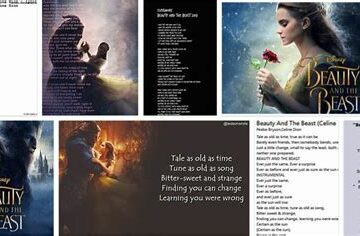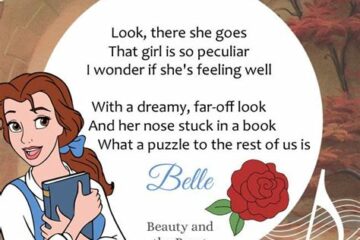Understanding The Ending: What It Means In Beauty And The Beast

Understanding The Ending: What It Means In Beauty And The Beast
Understanding The Symbolism Behind The Ending Of Beauty And The Beast
The ending of Beauty and the Beast is rich with symbolism, conveying deeper messages that resonate beyond the fairy tale’s surface narrative. One of the most striking symbols is the rose. Throughout the story, the enchanted rose represents not only the Beast’s curse but also the fragility of love and time. As the petals fall, they signify the urgency of the Beast’s redemption and the fleeting nature of beauty and time. This symbol emphasizes the importance of seizing the moment to love and be loved before it is too late.
Another significant symbol in the ending is transformation. The climactic moment when the spell is broken serves as a powerful representation of inner change. The Beast’s transformation back into a prince parallels the journey of self-discovery and acceptance that both he and Belle undergo. Their love does not merely change external appearances; it reshapes their identities, emphasizing that true beauty arises from within and is discovered through love and sacrifice.
The castle itself symbolizes isolation and entrapment, contrasting with the warmth and connection that Belle brings. When the castle is transformed from dreariness to a place of joy following the breaking of the spell, it signifies the restoration of hope, love, and community. This transformation highlights the profound impact that love can have on both individuals and their surroundings.
In understanding the ending, we also acknowledge the duality of fate and choice. While the characters face dire consequences due to their actions, it is their choices—particularly Belle’s courage and the Beast’s willingness to change—that ultimately craft their destinies. This intertwining of fate and free will underscores an essential lesson: while life may set the stage, it is our choices that direct the narrative.
Thus, the ending of Beauty and the Beast is not merely a resolution of a love story; it is a layered tapestry of symbolism that encourages audiences to reflect on the intrinsic qualities of love, transformation, and the essence of beauty itself. In doing so, it invites viewers to consider their own relationships and the symbols that they might find within their journeys.
How The Ending Reflects Character Development In Beauty And The Beast
The conclusion of Understanding The character development in Beauty and the Beast is pivotal for both the protagonists, Belle and the Beast. Their transformation throughout the story culminates in the ending, showcasing how personal growth and emotional depth evolve through their interactions and experiences.
Initially, the Beast embodies rage and despair, a reflection of his past mistakes and the curse placed upon him. However, as Belle enters his life, the Beast begins to shed layers of anger and isolation, revealing his vulnerabilities. This change is emblematic of his journey towards redemption. By the conclusion, his willingness to embrace love, even at the cost of potential loss, represents a profound character shift from selfishness to selflessness.
On the other hand, Belle’s character arc mirrors this growth. From a young woman yearning for adventure and understanding, she matures into a figure of compassion and strength. Her decision to love the Beast despite his physical appearance demonstrates an evolution in her perception of beauty and identity. The ending solidifies her role not just as a romantic partner, but as a catalyst for change in the Beast’s life.
Moreover, their union signifies not only personal healing but also emphasizes the importance of looking beyond the surface. Understanding The essence of character development in Beauty and the Beast challenges audiences to recognize that true beauty lies within. The culmination of their story reinforces the notion that love, kindness, and acceptance can lead to transformative change, enriching their lives and imparting valuable life lessons to viewers.
Understanding The Ending’s Impact On Audience Emotions And Expectations
The ending of Beauty And The Beast holds significant weight in shaping audience emotions and expectations. It combines elements of joy, relief, and fulfillment while simultaneously addressing deeper themes such as transformation, acceptance, and unconditional love.
Initially, the audience is led through a spectrum of emotions, from tension as Belle confronts her fears to despair as the Beast faces the consequences of his past. However, the closing moments pivot dramatically, invoking a sense of catharsis and hope. The climactic transformation of the Beast back into a prince serves as a powerful symbol of redemption, resonating deeply with viewers who have invested in the characters’ journeys.
Moreover, the ending reinforces the narratives that good ultimately triumphs over evil, and love can transform even the most hardened hearts. This resolution not only fulfills the audience’s desire for a happy ending but also sets a precedent for moral integrity in storytelling. In essence, the emotional journey culminates in a satisfying conclusion that meets identified expectations while offering a poignant reminder of the power of love and understanding.
Additionally, the ending’s influences extend to broader cultural expectations surrounding fairy tales. Viewers often anticipate moral lessons and transformations in such narratives, and understanding the ending of Beauty And The Beast encapsulates these themes succinctly. As a result, it creates a lasting impact on the audience, encouraging them to reflect on their beliefs about love, acceptance, and personal growth.
Lessons Learned From The Ending Of Beauty And The Beast
The ending of Beauty and the Beast teaches us invaluable lessons about love, acceptance, and personal transformation. At its core, the story emphasizes the idea that true beauty lies within, a theme that resonates deeply with audiences of all ages. Here are a few key lessons we can draw from the conclusion of this timeless tale:
- Understanding The importance of seeing beyond the surface: The Beast’s transformation into a prince exemplifies the notion that outward appearances are not always reflective of one’s true character. This teaches viewers to appreciate inner qualities over physical traits.
- Redemption is possible: The Beast’s journey from a lonely, angry creature to a loving partner illustrates that change is achievable. It reinforces the belief that with love and compassion, even the most lost individuals can find their way back to themselves.
- The power of love and sacrifice: Belle’s willingness to sacrifice her freedom for her father showcases the strength of familial love. Additionally, the love story between Belle and the Beast highlights that emotional connections are built on understanding and mutual respect.
- Acceptance of oneself and others: The ending encourages acceptance of oneself and others, showcasing that embracing our flaws and imperfections makes us human. This message motivates audiences to cultivate kindness and empathy in their own lives.
The lessons learned from the ending of Beauty and the Beast remind us of the transformative power of love and the importance of understanding the true essence of beauty, acceptance, and growth in our relationships and interactions with others.
Understanding The Cultural Significance Of Beauty And The Beast’s Conclusion
The ending of Beauty And The Beast holds profound cultural significance that transcends mere entertainment. This timeless tale provides insight into societal values and norms, particularly surrounding themes of love, acceptance, and transformation. As the story concludes, the triumph of love over superficial barriers highlights an essential message: true beauty lies within.
In many cultures, the notion that love can redeem and transform individuals is powerful. The conclusion reaffirms the belief that genuine connections can help overcome personal flaws and societal prejudices. The Beast, once feared and misunderstood, becomes a symbol of transformation, illustrating how vulnerability and authenticity can bridge divides.
Moreover, the conclusion reinforces the traditional roles of gender and relationships while also introducing elements of empowerment. Belle’s journey to understanding and accepting the Beast challenges stereotypes and notions of romantic love. Her agency as a character encourages audiences to rethink the dynamics of relationships, emphasizing mutual respect and emotional depth.
This duality makes the ending resonate across different cultures, allowing audiences worldwide to find elements of their own experiences within the narrative. In essence, the cultural significance of Beauty And The Beast’s conclusion lies in its ability to reflect and shape societal attitudes, making it a timeless tale that continues to be relevant across generations.
Top 10 Disney Characters You Didn’t Know About
December 30, 2024A Deep Dive Into Disney Princesses And Their Stories
December 29, 2024The Meaning Behind Beauty And Beast Lyrics
December 29, 2024Why Beauty And The Beast Is A Timeless Disney Classic
December 29, 2024The Role Of Disney Princesses In Modern Culture
December 29, 2024Exploring The Themes In Beauty And The Beast Lyrics
December 28, 2024
Leave a reply Cancel reply
Recommended
-
The Use Of Color In Conveying Emotion In Beauty And The Beast
December 6, 2024 -
The Connection Between Beauty And The Beast Lyrics And Literature
December 23, 2024 -
Beauty And The Beast Opening Song Lyrics
August 25, 2023









